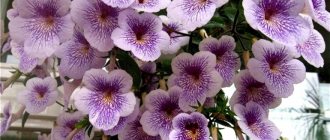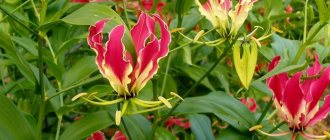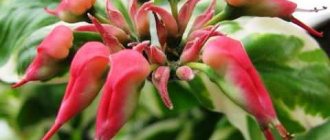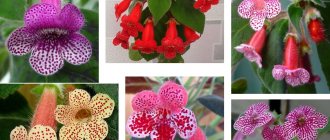Blooms in late spring - summer. Spike-shaped inflorescences consisting of numerous stamens appear at the tops of young shoots. In appearance, the flowers resemble brushes used to wash dishes. Thanks to the bright fluffy inflorescences, the tree looks elegant. Under natural conditions, the plant is found in New Caledonia, Tasmania, and the homeland of callistemon is Australia.
Also look at the wonderful myrtle plant from the same family.
| average growth rate. |
| Blooms from mid-spring to late summer. |
| Average ease of growing. |
| Perennial. |
Useful properties of callistemon
Callistemon leaves contain essential oils. A pleasant smell can be felt by rubbing them with your fingers or accidentally damaging a leaf. Essential oils, when evaporated, enrich the air with phytoncides, thereby reducing the risk of a cold. The aroma of callistemon calms the nervous system and improves mood. The healthy cuttings remaining after pruning are used in a home beauty salon: they are used to prepare decoctions and tinctures that improve the condition of problem skin.
Propagation by cuttings
Callistemon cuttings photo
Callistemon is also propagated by cuttings. Lignified apical shoots 5-8 centimeters long are used. The cuttings take root with water or in moist vermiculite for about two months. To make the process happen faster, the cuttings are treated with a growth stimulator before rooting. They are planted in mini-greenhouses with bottom heating, maintain high humidity inside and systematically ventilate.
Callistemon: home care. Briefly
In order for callistemon to grow into a beautiful tree at home, you need to try and create optimal conditions:
| Temperature | in summer – no higher than + 22°C, in winter – 10 – 12°C. |
| Care according to the seasons | in winter, the young tree is kept in good light; in summer they take it outside; after a year, they are planted in the garden for the warm season, moved home in winter and arranged for a cool winter; callistemon will bloom in summer |
| Air humidity | moderate; in the summer they spray it every other day and give it a shower |
| Lighting | bright; placed on the south, southwest or southeast windows. |
| Watering | in winter - once every 12 days, in summer - once every 8 days; good drainage is needed. |
| Soil for callistemon | universal soil for flowers or a soil mixture of equal parts of humus, leaf soil, sand and turf soil. |
| Feeding and fertilizer | once every 2 weeks - with universal mineral fertilizer, diluted several times; sometimes with diluted organic fertilizer. |
| Callistemon transplant | young plants - every year, in spring; adults - every 3 years. |
| Reproduction | using seeds and cuttings. |
| Features of cultivation | With the onset of warm weather, the bush is taken out onto the balcony or into the garden: an influx of fresh air is necessary for the growing season. After each flowering, callistemon shoots are pruned to stimulate branching of the plant and lay the foundations for new flowering. |
Description of appearance, photo and features of the plant
Callistemon is a prominent representative of evergreen plants belonging to the Myrtle family. Under natural conditions it grows on the Australian continent. In nature, there are tree-like varieties that grow up to 15 m in height, but at home these sizes are much smaller. The shoots begin to branch almost from the very root, and over time, a heterogeneous crown is formed, irregularly shaped with branches sticking out in all directions. This feature does not spoil the bush in any way, and if necessary, it can be trimmed to create a more even outline.
On all shoots, lanceolate-shaped leaf plates are arranged in a spiral. The central vein is clearly visible throughout the entire surface, and you can also see small glands from which essential oils are secreted.
The flowering period begins in late spring or early June.
The inflorescences are formed in the shape of a spike, on which there are no petals inherent in other representatives of the myrtaceae. Externally, it is a large bunch consisting of stamens in yellow-red color. In nature you can also find varieties with yellow, white or orange stamens. The inflorescences are about 12 cm in length and approximately 6 cm in cross section.
Interesting! Under natural conditions, pollination is possible with the help of small birds flying to the aroma of sweet nectar. After flowering, a spherical fruit capsule appears, which is fully ripe by autumn. Its outer covering is quite hard, has a woody structure, and inside there are brown seeds.
Essential oils released from the veins of leaf blades have a beneficial effect on indoor air. They disinfect it, destroying most of the harmful microbes and bacteria.
Callistemon leaves always turn towards the sun, oriented with an edge. This feature helps retain moisture, reducing the level of heating of the sheet surface.
Caring for callistemon at home. Details
Even a novice gardener can successfully grow a beautiful flowering callistemon bush at home if he truly loves plants and tries to create optimal conditions for his green pet.
Callistemon flowering
At the end of spring, callistemon begins to bloom.
The spectacle impresses with its originality and beauty. The unusualness of the flowering plant lies not in the elegance, delicacy or color of the petals (they are generally hard to see), but in the large number of bright stamens with a golden dot at the end. Red, crimson, cream, orange and even green stamens on the tops of young shoots are collected in fluffy spike-shaped inflorescences. Their length often reaches 13 cm, and their width ranges from 5 to 10 cm. After flowering is completed, the stamens are replaced by round fruits that cling tightly to the shoots. At home, callistemon does not form seeds, because birds do not pollinate it here.
Temperature
In order for the callistemon plant to develop correctly and bloom beautifully at home, it is necessary to observe the temperature regime. To do this, keep the tree cool in winter, without raising the temperature above + 12°C. In summer, callistemon develops well at + 20 – 22°C and frequent ventilation.
The plant should be protected from drafts and not placed near an air conditioner.
Spraying
Homemade callistemon has a reserved attitude towards dry air and prefers moderate humidity from 35 – 60%. In the summer, the tree is sprayed several times a week and given a warm shower. The procedure will also protect the plant from pests. Open containers with water are placed next to the pot. This is especially important during the heating season.
Lighting
The callistemon tree is sensitive to light; for normal growth it needs not just good, but bright lighting. It should be borne in mind that excess light can cause leaf burns, and its lack will negatively affect flowering.
Therefore, caring for callistemon at home recommends placing the plant in the southern, southwestern or southeastern parts of the room. If you place a pot with a tree on a window facing south, it must be shaded from the bright sun at noon. If there is not enough light, turn on the phytolamps.
Watering callistemon
Callistemon is a moisture-loving plant.
When caring for it, it is important to ensure that the soil does not dry out. In summer, callistemon is watered every 8 days, in winter - every 10 days. Water with well-settled lukewarm water. If the water contains a lot of chlorine, it is softened by adding 0.2 g of citric acid or 2 - 3 drops of lemon juice per liter of water. It is useful to water callistemon with this water up to three times a month. Do not allow moisture to stagnate in the soil. Stagnation leads to rotting of the root system. To prevent the death of the plant, create a good drainage layer, and add raising agents (vermiculite, perlite, agrovermiculite) to the soil.
Callistemon pot
The development of the plant depends on the correctly selected pot. A pot for callistemon needs to be moderately deep so that its root system and drainage layer can fit there. In this case, the container should be a little cramped. This is necessary for beautiful callistemon flowering.
If the pot you purchased does not have drainage holes, you will need to make them yourself.
Priming
The tree can be planted using a universal flower substrate that has a slightly acidic reaction. You can also prepare soil for callistemon with your own hands, taking leaf soil, humus, sand, and turf soil in equal parts. To improve the quality of the substrate and enhance drainage properties, chopped sphagnum, brick chips, vermiculite, and coconut substrate are added to it.
Feeding and fertilizer
To ensure beautiful flowering and keep the plant in good shape, fertilizing and fertilizer are used. From the beginning of March until mid-autumn, use a universal remedy for flowering plants, diluted in half. It is necessary to pay attention that the fertilizing contains a minimum amount of calcium: it has a bad effect on the tree.
Sometimes organic matter is used in highly diluted form. Feed callistemon once every 14 days, after evening watering. After feeding, the plant is shaded for a day. In winter, all fertilizers are canceled. After transplantation, 2 weeks should pass, then feeding is resumed, otherwise the tree can easily be overfed.
Transfer
Young trees are replanted every spring. Callistemon grows intensively, quickly developing a root system. Mature callistemon is transplanted when its roots completely engulf the earthen ball - approximately every three years.
For completely mature plants, the top layer of soil is renewed. When replanting, the pot is replaced with a container of larger diameter.
How to trim callistemon
To ensure that the callistemon crown looks perfect, thin and damaged shoots are pruned every year after flowering. Pruning promotes good branching and beautiful flowering of the plant. Young specimens are pinched so that they do not stretch to gigantic sizes.
Callistemon bonsai
Original bonsai-style compositions made from callistemon perfectly enliven the interior. To create a unique tree, use wire and small weights. Using these materials, callistemon shoots are bent in the desired direction and secured with weights.
When the branches become woody, the devices are removed. The shoots are shortened to the desired length. This neat mini-tree will delight you with its unusual shape.
Rest period
From mid-October, callistemon begin to prepare for wintering. Reduce watering and gradually lower the temperature. The resting period of callistemon falls in November - February. At this time, the plant is not fed; Water rarely, but make sure that the soil does not dry out or become crusty. There is no need to reduce the lighting intensity, otherwise the callistemon will bloom poorly.
If there is not enough light at home, turn on additional lighting.
Details
Kinds
Varieties of callistemon at home
In the genus of beautiful stamens you can find 37 varieties, but in our regions lemon or citrus callistemon is popular. This name comes from the plant's lemon-like aroma. The variety was originally only found in Australia.
Lemon callistemon has branches growing in different directions, and its average height is 2 m. The leaf blades are lanceolate, painted in a dark bottle color. They are about 10 cm in length and 8 cm in width. Peak flowering occurs in July, and the inflorescences are painted a rich crimson color.
Among the varieties of citrus callistemon, there are several of the most famous varieties:
- White Anzac - this variety has one distinctive feature in the form of the formation of white inflorescences, the height of the bush itself is 1.5 m;
- Reeves pink - the inflorescences of this variety are painted soft pink;
- Devens Rowena is a bush that produces stamens that are bright red and gradually fade to paler shades. By the time they wilt they become light pink. The bush itself does not grow more than 1.5 m.
- Mauve Mist - this variety differs from all others by the presence of purple stamens in large quantities.
In addition to lemon callistemon, you can also find the following varieties:
- Callistemon red grows in southern Australia, and in appearance it is a shrub that in nature grows up to 4 m in height. As an adult, it looks more like a tree than a bush. It is distinguished by the presence of thin, elongated leaves that are hard to the touch. The formed stamens are red in color and have yellow anthers that give the appearance of a golden color.
- Callistemon willow is the most popular among its relatives and grows in nature in a subtropical climate. In such conditions, it takes the form of a tree, growing to a height of 15 m. This plant has one distinctive feature in the form of a creamy bark, similar to thin paper. The formed inflorescences are also painted in light tones of white, cream, beige or light pink. This species grows very quickly.
- Callistemon pine grows up to 3 m in height, has short and thin leaves, similar to the needles of coniferous varieties. Young shrubs have grayish bark, while in older specimens it becomes emerald. During flowering, greenish stamens appear.
- Callistemon rodoformis is a very beautiful species that also grows in Australia. Under natural conditions, the shrub reaches 8 m. The leaf blades on the shoots take the shape of an oval with a pointed end and grow up to 7 cm in length. The flowering period begins in early summer, at which time deep red inflorescences with stamens of a darker shade appear.
- Callistemon hard is slightly different from the representatives of this family, and has the appearance of a compact shrub with vertically growing shoots. During flowering, fluffy crimson inflorescences appear.
- Callistemon beautiful is presented in the form of a shrub, which adapts to cool weather better than all other varieties. Its leaf blades are quite narrow and do not exceed 6 cm in width. The flowering period begins in early summer, and the variety itself is very decorative.
How to plant callistemon correctly?
The growing process itself is not at all difficult if you follow some rules and start right from planting.
First of all, you will need to purchase cuttings or seeds. It is best to postpone this procedure until spring and summer. If you grow plants in open ground, then you need to do this in the warm season.
The following components are used as soil:
- 4 parts of turf land;
- 2 parts of deciduous soil and peat;
- 1 part river sand.
If planting in a container, be sure to lay out a drainage layer that will prevent stagnation of liquid in the roots. Perlite can be used as a useful additive, which also serves as drainage.
It is best to use seeds that are not sprinkled with soil in a container, but distributed over the surface. The container must be closed, creating greenhouse conditions.
Since the red horned plant prefers illuminated areas, germination should be carried out in a bright room.
The resulting seedlings after seed propagation or cuttings can be planted in separate pots after complete rooting, which will be evident from the appearance of new shoots and leaves.
Interesting! Despite the fact that callistemon is a heat-loving plant, it reacts very poorly to hot, hot air. In winter, it is optimal for him to create a space with a temperature of about 16 degrees. In summer, these indicators should be within 20 degrees. During hot weather, it is useful to spray the crowns of bushes.
Transplanting callistemon into a new pot
At home, callistemon must be replanted annually in the spring. This plant has intensive growth, so it quickly gains root mass. Adult specimens are replanted upon request, when it is clear that the roots have completely entwined the former earthen ball. This is carried out approximately once every 3 years.
For very mature plants, you can simply change the top layer of soil.
Callistemon propagation methods
Most often, only 2 options are used: cuttings and seeds.
Seed propagation involves soaking the seed in a solution of potassium permanganate to reduce the development of bacterial infection. Sowing takes place in February. The seeds just need to be distributed over the surface of the finished substrate and covered with film. During germination, the temperature should be kept within 23 degrees, and it is important to ventilate the container daily for 15 minutes. When the soil dries out, it is moistened by spraying liquid using a spray bottle. With the emergence of seedlings, the shelter is removed, and the seedlings can be planted when they reach 6-8 cm in height.
Propagation by cuttings is best done in the fall, after scheduled pruning, when there is enough material left to obtain roots. To ensure that the cuttings take root faster, the cuttings are treated with stimulants and then planted in prepared soil with which the container is filled. The success of the procedure is determined by the appearance of young leaf buds.
Important! This propagation method involves flowering much earlier than with the seed method, and this difference is 2-3 years.
Callistemon indoors is very often found at home and this is all thanks to its unfading foliage and spectacular flowering. In addition, this plant emits a very pleasant aroma, which has a positive effect on the air.
Caring for callistemon at home
In terms of complexity, caring for callistemon can be assessed as average and the main activities are reduced to creating suitable conditions for growing.
Lighting
All varieties of this plant crop are light-loving and they tolerate direct sunlight more easily than constant shade. This bush can be placed on the south side of the house, and it will not suffer at all from this.
Since callistemon grows large even at home, an adult specimen is unlikely to fit on a windowsill. He needs to find a place closer to the window, because it is the lighting that affects the intensity and duration of flowering. If it is impossible to provide the proper level of light, you will need to connect phytolamps.
Air temperature
This indicator also has a great influence on the flowering period and its abundance. In summer or spring, when it gets warmer outside, the temperatures indoors should also rise. A similar situation should occur with a decrease in outdoor temperature. In general, indoor seasonal fluctuations are possible within 5 readings on the thermometer.
Interesting! In winter, a dormant period begins, so if a cooler environment is not created, the plant will not be able to fully rest and bloom next year.
Soil and air humidification mode
It is very important to use settled water at room temperature for irrigation. The decorative quality of a bush can be reduced both with an excess of moisture and with its lack. Watering should be as regular and moderate as possible, and focus on the condition of the top layer of soil. The surface should not be swampy or excessively dry.
As for air humidity, it is kept within 75%. The bush should be sprayed regularly, especially in summer and spring. During the rest period, these actions can provoke the appearance of a fungal infection.
Fertilizer for callistemon
Regular feeding promotes beautiful and long-lasting flowering, as well as uniform crown formation. Mineral supplements should be added with the arrival of spring and before the start of preparation for the sleep phase. In this case, complex fertilizers for flowering crops are used, but the concentration should be reduced by 2 times from the recommended one.
Important! When applying fertilizers, it is necessary to give preference to those that contain a minimum of calcium. This component negatively affects the external condition of callistemon.
For variety, you can use organic fertilizers in the form of a weak solution. The frequency is once every 2 weeks and applications are carried out in the evening, after regular watering.
During a planned transplant, callistemon needs 2 weeks to adapt, and during this time, feeding is excluded.
Bush pruning
The callistemon plant must be trimmed annually after flowering, removing thin or damaged shoots. This promotes more branching and the appearance of new inflorescences next year. Young callistemon seedlings must be pinched to limit the height of the plant.
Preparing callistemon for winter
These activities begin in mid-autumn, and from that moment on, watering is reduced and the room temperature decreases. Rest lasts from November to February, during this time all fertilizing is excluded, and you only need to water the soil so that it does not become crusty. During the dormant period, only the lighting does not change; it should be as intense as during the normal growing season.
Callistemon reproduction
Callistemon is propagated at home in two ways.
Growing callistemon from seeds
Held in the first half of February. The seeds are soaked in potassium permanganate, then laid out on a moistened substrate and covered with glass or film. The container with the crops is kept in a warm room at + 23° C. The cover is removed for watering and ventilation. When shoots appear, the shelter is removed. Young seedlings that have grown to 7 cm are planted in separate pots.
Callistemon propagation by cuttings
Carry out after pruning the plant. Cut off strong cuttings are treated with a root formation stimulator and planted in moist soil. A sign of successful rooting will be the appearance of young leaves. Then the cuttings are transplanted into separate containers.
Propagation by cuttings is the most affordable and fastest way to grow callistemon at home. A tree obtained in this way will bloom earlier.
Reproduction methods
Growing from seeds
Indoor callistemon can be grown from seeds. They are sown from early to mid-February. To begin with, they are kept for some time in a solution of potassium manganese, and then evenly distributed over the surface of the wet soil mixture. The crops are covered with film or glass on top and transferred to a warm place (about 23 degrees). They are regularly ventilated and moistened.
After the first seedlings appear, the shelter is removed. Planting into individual pots is carried out when the length of the seedlings is approximately 70 mm.
Cuttings
The cutting procedure is combined with pruning. The lower part of strong, healthy cuttings is dipped into a solution of a root growth stimulating agent. Planting for rooting is carried out in a moist substrate. After the piece has taken root well, young leaves will appear on it. When this happens, you need to transplant the bush into a permanent pot.
The easiest and fastest way to propagate homemade callistemon is by cuttings. Such a bush will begin to bloom earlier than the one grown from seeds.
Callistemon. Cuttings, rooting | Callistemon
Diseases and pests
If not properly cared for, callistemon can sometimes be affected by diseases and pests. The appearance of the plant will immediately tell you about the troubles:
- callistemon leaves dry and fall off - excess moisture, lack of lighting (change the substrate, adjust watering and move to a brighter place);
- callistemon dries out - substrate with an alkaline reaction (use fertilizers that do not contain calcium; transplant into slightly acidic soil);
- grows slowly and blooms poorly - poor lighting (move to a brighter place);
- leaves fall off - excess moisture or placement in a draft (transplant into another soil, adjust watering; protect from drafts);
- yellow and brown spots on callistemon leaves – sunburn (in hot weather, cover from bright direct rays of the sun; spray in the shade or in the evenings).
Callistemon is resistant to attack by pests, but sometimes it is affected by scale insects, spider mites, and mealybugs. Insecticides are used against insects.
Main types
Callistemon is an evergreen shrub native to New Caledonia (Australia). Belongs to the Myrtaceae family. The first scientific description was given by the English naturalist Joseph Banks in 1789. The first callistemon brought from New Caledonia “settled” in the Royal Botanical Garden.
Callistemon lemon.
In the natural environment, individual specimens can reach a height of 15 m. In the garden and at home, the sizes are more modest, from 50 cm to 1.5 m. The inflorescences are dense. Flower petals are practically absent. The stamens in flowers are much brighter than the petals. They come in fuchsia, scarlet, yellow, coral, orange, light green, white and cream. The length of the inflorescences can reach 13 cm, diameter - up to 6 cm.
The leaves are narrow, with a sharp, blade-like edge. Therefore, you need to be careful if there are children and pets, they may get hurt on the edge of the sheet metal. The color of the leaves is light green, with a grayish tint.
37 species grow in nature, but only 3 are well “domesticated”:
- Callistemon lemon.
- Callistemon rod-shaped.
- Callistemon red.
A little more about them below.
Callistemon lemon
The most popular representative of the species for home cultivation. The smell of essential oils released by the leaves is reminiscent of ripe lemon. This is reflected in the title.
The leaves are large, up to 10 cm long, the stamens are colored in different shades of pink, purple and white. Red stamen prefers to bloom in July.
In indoor plant stores you can find the following varieties of this flower:
- Mauve Mist - “sparkler candles” are colored purple.
Mauve Mist
- Reeves Pink - with pale pink stamens.
Reeves Pink.
- White Anzac - with beautiful white inflorescences.
White Anzac
- Devens Rowena is a polystamen plant with a smooth transition from red to bright pink. Withered inflorescences are pale pink.
Devens Rowena
Callistemon rodoformes
A medium-sized representative of beautiful stamens, the maximum height in nature is 7 m. The leaves are small, up to 5 cm in length, lanceolate, with a sharp edge.
Callistemon rodoformes
The stamens are bright red with burgundy anthers. Flowering begins in June. The inflorescences are dense, the bush is literally strewn with them. This flower is also called callistemon woven.
This variety of red stamen grows well indoors, forming a dense bush up to 1 m high. Even a busy person can care for this flower.
For reference: the Captain Cook variety is most often chosen and grown for home breeding.
Captain Cook
Callistemon red
Another interesting flower is the red callistemon (Callistemon coccineus).
A spectacular variety with two-colored stamens. The main part of the stamen is a rich scarlet color, and the anther is greenish-yellow.
Callistemon red grows well in the garden, in open ground.
Callistemon red
Types of callistemon domestica with photos and names
There are different types of callistemon that take root well at home.
Lemon Callistemon (Callistemon citrinus)
A short tree with a dense crown and scarlet inflorescences, the length of which reaches 0.1 m. Green leaves emit a pleasant lemon scent. A popular species with many varieties.
Callistemon viminalis
A low shrub with drooping shoots and bright orange or red inflorescences.
Callistemon salignus
A tall, well-branched shrub with whitish thin shoots and cream or bright white inflorescences with many golden stamens. Reminds me of a blooming willow tree.
Callistemon rigidus
A tall tree with erect, upward-pointing shoots and fluffy crimson inflorescences.
Callistemon bright red (Callistemon coccineus)
Tall (up to 4 m) shrub with gray-brown shoots and inflorescences of pink-red shades.
Pine Callistemon (Callistemon pityoides)
A tree up to 3 m high. The leaf blades are short and thin, similar to the needles of coniferous plants. The bark of young trees is gray with a silver tint; in adult plants it turns into dark emerald. The inflorescences are cream with a greenish tint.
Bright fluffy callistemon inflorescences bring comfort and joy to the home. The exotic's original appearance, combined with its absolute pickiness, explains its growing popularity.
Description of the culture of Callistemon
The spread of this tree in Russia has provoked great interest in it, therefore, before you try to grow it at home, it is worth knowing what kind of crop it is. Let's read a short description that will help put everything into perspective. The callistemon plant can be observed in both woody and shrub forms; gardeners often call it “red stamen” - this name is due to the unusual shape of the inflorescence. This tree blooms very beautifully with red “brush pipes” formed at the ends of the branches. Usually, this plant is not quite tall, but it is the bright stamens that make it attractive to gardeners and landscape designers. You can often see callistemon with unusual red, pink flowers, and a plant with lemon and pale yellow inflorescences is also common.
As for the height of the plant, it is usually no more than 15 meters, but it depends on the species, some of them do not exceed 0.5 meters. A rather original characteristic of this tree is that it has very sharp leaves, running alternately and having a rather leathery and hard base.
Callistemon has fruits that can be box-shaped. But, most often you can see spherical or ovoid. Being a cross-pollinated plant, it is pollinated mainly by birds.
Most often, callistemon can be seen in its homeland - Australia, but they have also taken root well in New Caledonia. Some Russian gardeners managed and were even able to plant these plants in their gardens, creating for them moist, light soil consisting of a greater percentage of sand.
Such types of callistemon as Lemon, Beautiful and Plutovidny, which can be seen closer in the photo below, have become widespread in Russia.
Care according to the seasons
In winter, a young exotic will be comfortable in the brightest place, and in the summer months it can be taken out into the yard under cover. A year later, in the spring, the bush can be pampered by planting it outside, and by autumn it will already be a lush callistemon tree with a densely leafy crown. In the fall, it should be replanted in a pot and wintered in a bright, cold corridor at a temperature of 7-10 ° C. The tree can winter almost without watering. In the summer, in the fourth year of life, callistemon will reward your efforts and delight you with its first flowering.
It should be taken into account that with good care, this special tree can grow not only high, almost up to two meters, but also wide. There won't be enough space for him in the apartment. Then such a colossus can be installed, for example, in a school. The conclusion follows from this: callistemon requires obligatory pinching, and when the height of the plant reaches 20-30 centimeters. To prevent the exotic from overgrowing, the branches should be shortened every spring, thereby forming a compact tree or bush.
Callistemon planting
I sowed the seeds of this beautiful plant on the surface of moist soil, covered it with glass and placed it in a mini-greenhouse near the window.
I did everything as it was written on the bag. The seedlings were transplanted into separate cups. They grew very slowly, but were strong and stocky. When replanting in spring into slightly larger pots, I used a light substrate: peat, compost and humus soil with the addition of well-decomposed pine litter.
Callistemon loves watering, but does not tolerate stagnant water in the soil, so when planting it, I made drainage from expanded clay.
Choosing a site for planting and preparing the soil
To plant callistemon, it is recommended to choose the eastern, western or southern side. The main thing is that there is a lot of diffused light in this place.
Although the culture has an exotic origin, it does not tolerate hot weather well. In the summer, the optimal temperature is +20-22 degrees. In winter it should be +12-16 degrees.
It is recommended to plant the crop in a nutrient substrate. To prepare it, you need to mix turf soil, deciduous soil, peat and river sand in a ratio of 4:2:2:1.
Landing dates
It is allowed to plant indoor flowers in the ground from August to March.
Planting a plant
Flower shops sell ready-made plants. You can also purchase seeds or cuttings.
When propagating a flower with seeds, you should use a medium-sized pot. It is recommended to place a drainage layer of perlite at the bottom. Then pour in the nutrient substrate and place the seeds in it.
After this, it is recommended to cover the pot with glass or film, place it near the window and water it twice a day. After 2-3 weeks, sprouts will appear.
Drainage is required when planting
Medicinal properties
Callistemon leaves contain essential oils. They help clean the air and ensure people's health. These substances have pronounced bactericidal properties.
Callistemon is a popular ornamental plant grown by many plant lovers. To achieve normal development and abundant flowering of a crop, it is necessary to provide it with high-quality care. It should include timely watering, fertilizing, and pruning.
The amazing is nearby, and how little we know about the plant world! Few people have seen the bright scarlet brushes of Callistemon, which will be discussed in this article.
Like a miracle tree growing at our gates: Miracle, miracle, miracle, wonderful miracle! Not the leaves on it, not the flowers on it, the brushes are turning red, like light bulbs. Korney Chukovsky
Brush-brushes are those flowers, thanks to which this tree is called several names: Callistemon, Krasnotychinnik, also known as Krasnotychinnik. This exotic plant stands out for its extraordinary beauty among ornamental home shrubs; it is a fast-growing evergreen tree with picturesque flowers and fragrant foliage. The red anthrower adapts to any conditions, demonstrating miracles of adaptation.
The plant comes from the Myrtaceae family, and these are mainly low evergreen trees, less often shrubs, numbering more than forty species. In Australia, in its homeland, Callistemon grows up to eight meters in its natural environment. There are facts confirming that some species can reach the height of a six-story building - up to eighteen meters.
This exotic species was brought to Europe in 1789. The plant was appreciated not only by flower growers in many countries. So the Germans likened it to brushes for cleaning fireplaces, the British - to brushes for cleaning the glass of kerosene lamps, smokers - systematically tried to clean pipes using its inflorescences
Reproduction
Callistemon is propagated by sowing seeds and cuttings. They begin to grow it from seeds in August-March. Seeds are sown without preliminary preparation on the surface of moist sandy-peat soil. The container should be covered with film, ventilated daily and sprayed with soil as needed. Shoots appear within a month, after which the film is removed. When the seedlings grow two true leaves, they are planted in separate small pots. Plants develop slowly and bloom in 5-6 years.
A more convenient method of propagating callistemon is cuttings. It is necessary to wait until the adult plant has developed well and has lateral shoots 7-12 cm long. Cuttings with 3-4 internodes are cut off. The lower cut is treated with phytohormones for root development. They are planted in pots with sand or sand-peat soil. The seedlings are covered with a cap, but ventilated daily. Warming the soil can speed up rooting. Within two months, about half of the cuttings take root.











